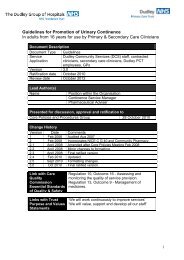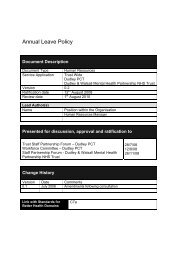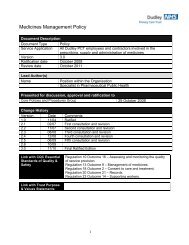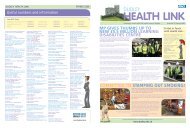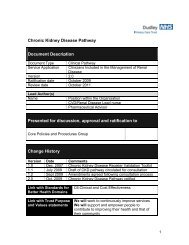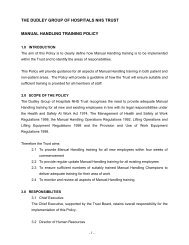Dudley Strategy for Tackling Health Inequalities 2010-15
Dudley Strategy for Tackling Health Inequalities 2010-15
Dudley Strategy for Tackling Health Inequalities 2010-15
- No tags were found...
Create successful ePaper yourself
Turn your PDF publications into a flip-book with our unique Google optimized e-Paper software.
instability. Factors such as job security, job satisfaction, supervisor and peersupport, are related to both psychological and physical health impacts includingdepression, cardiovascular disease, coronary heart disease and musculo-skeletaldisorders.Psycho-social hazards of low worker control, having a large number of demands andlittle support at work combine these factors into „isostrain‟. Work stresses measuredby isostrain have been shown to increase the risk of the metabolic syndrome (acombination of risk factors <strong>for</strong> diabetes and heart disease).On the basis of the evidence reviewed, Marmot (<strong>2010</strong>) concludes that getting peopleinto work is of critical importance <strong>for</strong> reducing health inequalities but these jobs needto be sustainable and offer a minimum level of quality including not only a decentliving wage but opportunities <strong>for</strong> in-work development and flexibility to balance workand family life with protection from adverse working conditions that can damagehealth.The importance of getting people into work has been recognised <strong>for</strong> almost twodecades now by policy makers and a variety of schemes referred to as „active labourmarket programmes‟ have been implemented to integrate the unemployed into work,rather than simply providing passive income support when people are out of work.The Marmot Review (<strong>2010</strong>) of effectiveness shows that active labour marketprogrammes implemented since the middle 1990s have had some success in termsof labour market outcomes. It is of particular note that the groups <strong>for</strong> whom noprogramme of assistance was available over this period, young people aged 16 and17, saw unemployment rise steadily even through a period of economic growth. 1 in4 of the economically active in this age group was unemployed in 2007. The currentrecession obviously poses a major threat <strong>for</strong> progress made up until 2007.There is some evidence that active labour market programmes have contributed toincreasing income amongst recipients, though they are most effective whencombined with other fiscal and benefit measures to „make work pay‟. There hasbeen little research on the subsequent effect of those improved labour marketoutcomes on health outcomes. There is some limited evidence that participation ingovernment training programmes can have positive effect on the psychologicalhealth and subjective wellbeing of the participants compared with unemployedpeople not involved in such programmes. The effects of active labour marketprogrammes seem to vary in relation to a range of individual factors including theinitial attitude of participants to work („job readiness‟) and the effectiveness of theirallocated advisors. The evidence <strong>for</strong> a positive impact of active labour marketprogrammes <strong>for</strong> people with mental health difficulties is much stronger. Vocationalrehabilitation services, particularly individual placement and support services (IPS)can significantly increase rates of employment <strong>for</strong> those with mental illness.34




